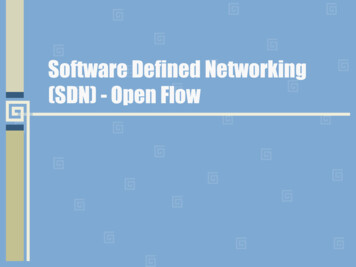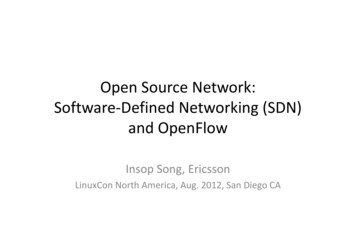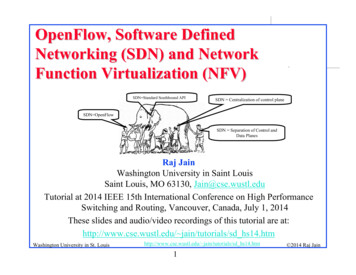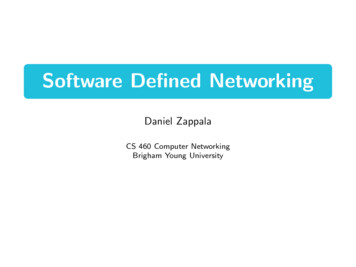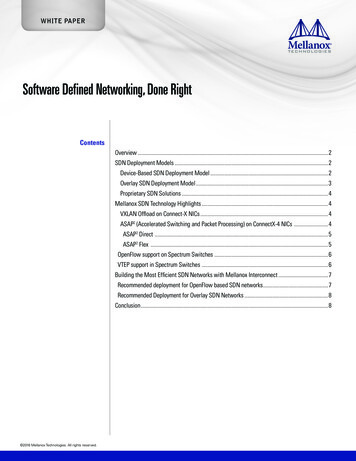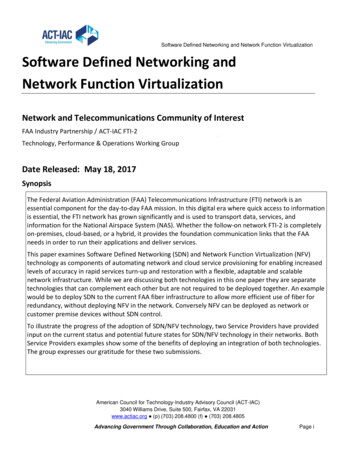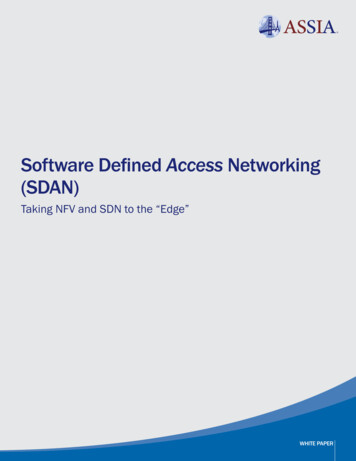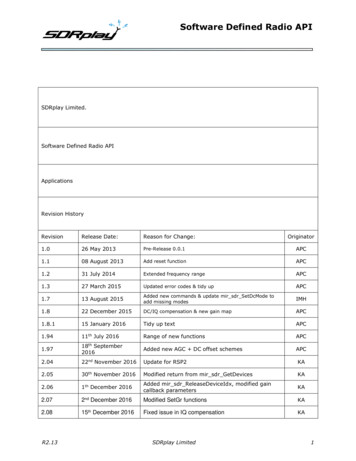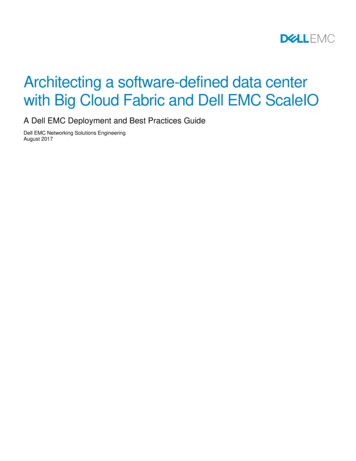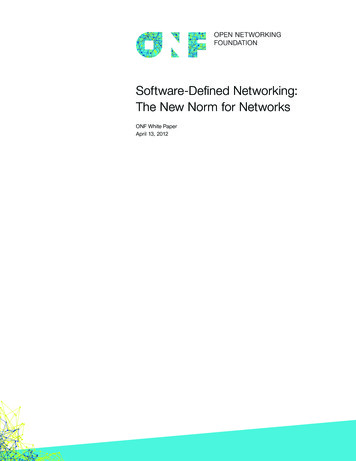
Transcription
Software-Defined Networking:The New Norm for NetworksONF White PaperApril 13, 2012
O N F W H I T E PA P E RSoftware-Defined Networking: The New Norm for NetworksTable of Contents2Executive Summary3The Need for a New Network Architecture4Limitations of Current Networking Technologies7Introducing Software-Defined Networking8Inside OpenFlow10Benefits of OpenFlow-Based Software-Defined Networks12ConclusionExecutive SummaryTraditional network architectures are ill-suited to meet the requirements oftoday’s enterprises, carriers, and end users. Thanks to a broad industryeffort spearheaded by the Open Networking Foundation (ONF), SoftwareDefined Networking (SDN) is transforming networking architecture.In the SDN architecture, the control and data planes are decoupled,network intelligence and state are logically centralized, and the underlyingnetwork infrastructure is abstracted from the applications. As a result,enterprises and carriers gain unprecedented programmability, automation,and network control, enabling them to build highly scalable, flexiblenetworks that readily adapt to changing business needs.The ONF is a non-profit industry consortium that is leading the advancementof SDN and standardizing critical elements of the SDN architecture suchas the OpenFlow protocol, which structures communication between thecontrol and data planes of supported network devices. OpenFlow is the firststandard interface designed specifically for SDN, providing high-performance,granular traffic control across multiple vendors’ network devices.OpenFlow-based SDN is currently being rolled out in a variety ofnetworking devices and software, delivering substantial benefits to bothenterprises and carriers, including: Centralized management and control of networking devices from multiplevendors; Improved automation and management by using common APIs to abstractthe underlying networking details from the orchestration and provisioningsystems and applications; Rapid innovation through the ability to deliver new network capabilities andservices without the need to configure individual devices or wait for vendorreleases; Open Networking Foundation. All rights reserved.2 of 12
O N F W H I T E PA P E RSoftware-Defined Networking: The New Norm for Networks Programmability by operators, enterprises, independent software vendors,and users (not just equipment manufacturers) using common programmingenvironments, which gives all parties new opportunities to drive revenueand differentiation; Increased network reliability and security as a result of centralized andautomated management of network devices, uniform policy enforcement,and fewer configuration errors; More granular network control with the ability to apply comprehensive andwide-ranging policies at the session, user, device, and application levels; and Better end-user experience as applications exploit centralized networkstate information to seamlessly adapt network behavior to user needs.SDN is a dynamic and flexible network architecture that protects existinginvestments while future-proofing the network. With SDN, today’s staticnetwork can evolve into an extensible service delivery platform capable ofresponding rapidly to changing business, end-user, and market needs.The Need for a New Network ArchitectureThe explosion of mobile devices and content, server virtualization, andadvent of cloud services are among the trends driving the networkingindustry to reexamine traditional network architectures. Many conventionalnetworks are hierarchical, built with tiers of Ethernet switches arranged ina tree structure. This design made sense when client-server computingwas dominant, but such a static architecture is ill-suited to the dynamiccomputing and storage needs of today’s enterprise data centers,campuses, and carrier environments. Some of the key computing trendsdriving the need for a new network paradigm include: Changing traffic patterns: Within the enterprise data center, trafficpatterns have changed significantly. In contrast to client-server applicationswhere the bulk of the communication occurs between one client andone server, today’s applications access different databases and servers,creating a flurry of “east-west” machine-to-machine traffic before returningdata to the end user device in the classic “north-south” traffic pattern. Atthe same time, users are changing network traffic patterns as they pushfor access to corporate content and applications from any type of device(including their own), connecting from anywhere, at any time. Finally, manyenterprise data centers managers are contemplating a utility computingmodel, which might include a private cloud, public cloud, or some mix ofboth, resulting in additional traffic across the wide area network. Open Networking Foundation. All rights reserved.3 of 12
O N F W H I T E PA P E RSoftware-Defined Networking: The New Norm for Networks The “consumerization of IT”: Users are increasingly employing mobilepersonal devices such as smartphones, tablets, and notebooks to accessthe corporate network. IT is under pressure to accommodate thesepersonal devices in a fine-grained manner while protecting corporate dataand intellectual property and meeting compliance mandates. The rise of cloud services: Enterprises have enthusiastically embracedboth public and private cloud services, resulting in unprecedented growthof these services. Enterprise business units now want the agility to accessapplications, infrastructure, and other IT resources on demand and à lacarte. To add to the complexity, IT’s planning for cloud services must bedone in an environment of increased security, compliance, and auditingrequirements, along with business reorganizations, consolidations, andmergers that can change assumptions overnight. Providing self-serviceprovisioning, whether in a private or public cloud, requires elastic scalingof computing, storage, and network resources, ideally from a commonviewpoint and with a common suite of tools. “Big data” means more bandwidth: Handling today’s “big data” or megadatasets requires massive parallel processing on thousands of servers, allof which need direct connections to each other. The rise of mega datasetsis fueling a constant demand for additional network capacity in the datacenter. Operators of hyperscale data center networks face the dauntingtask of scaling the network to previously unimaginable size, maintainingany-to-any connectivity without going broke.Limitations of Current Networking TechnologiesMeeting current market requirements is virtually impossible with traditionalnetwork architectures. Faced with flat or reduced budgets, enterprise ITdepartments are trying to squeeze the most from their networks usingdevice-level management tools and manual processes. Carriers face similarchallenges as demand for mobility and bandwidth explodes; profits are beingeroded by escalating capital equipment costs and flat or declining revenue.Existing network architectures were not designed to meet the requirementsof today’s users, enterprises, and carriers; rather network designers areconstrained by the limitations of current networks, which include: Complexity that leads to stasis: Networking technology to date hasconsisted largely of discrete sets of protocols designed to connect hostsreliably over arbitrary distances, link speeds, and topologies. To meetbusiness and technical needs over the last few decades, the industry hasevolved networking protocols to deliver higher performance and reliability,broader connectivity, and more stringent security. Open Networking Foundation. All rights reserved.4 of 12
O N F W H I T E PA P E RSoftware-Defined Networking: The New Norm for NetworksProtocols tend to be defined in isolation, however, with each solving aspecific problem and without the benefit of any fundamental abstractions.This has resulted in one of the primary limitations of today’s networks:complexity. For example, to add or move any device, IT must touchmultiple switches, routers, firewalls, Web authentication portals, etc. andupdate ACLs, VLANs, quality of services (QoS), and other protocol-basedmechanisms using device-level management tools. In addition, networktopology, vendor switch model, and software version all must be taken intoaccount. Due to this complexity, today’s networks are relatively static as ITseeks to minimize the risk of service disruption.The static nature of networks is in stark contrast to the dynamic natureof today’s server environment, where server virtualization has greatlyincreased the number of hosts requiring network connectivity andfundamentally altered assumptions about the physical location of hosts.Prior to virtualization, applications resided on a single server and primarilyexchanged traffic with select clients. Today, applications are distributedacross multiple virtual machines (VMs), which exchange traffic flows witheach other. VMs migrate to optimize and rebalance server workloads,causing the physical end points of existing flows to change (sometimesrapidly) over time. VM migration challenges many aspects of traditionalnetworking, from addressing schemes and namespaces to the basic notionof a segmented, routing-based design.In addition to adopting virtualization technologies, many enterprisestoday operate an IP converged network for voice, data, and video traffic.While existing networks can provide differentiated QoS levels for differentapplications, the provisioning of those resources is highly manual. IT mustconfigure each vendor’s equipment separately, and adjust parameters suchas network bandwidth and QoS on a per-session, per-application basis.Because of its static nature, the network cannot dynamically adapt tochanging traffic, application, and user demands. Inconsistent policies: To implement a network-wide policy, IT may haveto configure thousands of devices and mechanisms. For example, everytime a new virtual machine is brought up, it can take hours, in some casesdays, for IT to reconfigure ACLs across the entire network. The complexityof today’s networks makes it very difficult for IT to apply a consistentset of access, security, QoS, and other policies to increasingly mobileusers, which leaves the enterprise vulnerable to security breaches, noncompliance with regulations, and other negative consequences. Open Networking Foundation. All rights reserved.5 of 12
O N F W H I T E PA P E RSoftware-Defined Networking: The New Norm for Networks Inability to scale: As demands on the data center rapidly grow, sotoo must the network grow. However, the network becomes vastlymore complex with the addition of hundreds or thousands of networkdevices that must be configured and managed. IT has also relied on linkoversubscription to scale the network, based on predictable traffic patterns;however, in today’s virtualized data centers, traffic patterns are incrediblydynamic and therefore unpredictable.Mega-operators, such as Google, Yahoo!, and Facebook, face even moredaunting scalability challenges. These service providers employ largescale parallel processing algorithms and associated datasets across theirentire computing pool. As the scope of end-user applications increases (forexample, crawling and indexing the entire world wide web to instantly returnsearch results to users), the number of computing elements explodesand data-set exchanges among compute nodes can reach petabytes.These companies need so-called hyperscale networks that can providehigh-performance, low-cost connectivity among hundreds of thousands—potentially millions—of physical servers. Such scaling cannot be done withmanual configuration.To stay competitive, carriers must deliver ever-higher value, betterdifferentiated services to customers. Multi-tenancy further complicates theirtask, as the network must serve groups of users with different applicationsand different performance needs. Key operations that appear relativelystraightforward, such as steering a customer’s traffic flows to providecustomized performance control or on-demand delivery, are very complexto implement with existing networks, especially at carrier scale. Theyrequire specialized devices at the network edge, thus increasing capitaland operational expenditure as well as time-to-market to introduce newservices. Vendor dependence: Carriers and enterprises seek to deploy newcapabilities and services in rapid response to changing business needs oruser demands. However, their ability to respond is hindered by vendors’equipment product cycles, which can range to three years or more. Lack ofstandard, open interfaces limits the ability of network operators to tailor thenetwork to their individual environments.This mismatch between market requirements and network capabilitieshas brought the industry to a tipping point. In response, the industryhas created the Software-Defined Networking (SDN) architecture and isdeveloping associated standards. Open Networking Foundation. All rights reserved.6 of 12
O N F W H I T E PA P E RSoftware-Defined Networking: The New Norm for NetworksIntroducing Software-Defined NetworkingSoftware Defined Networking (SDN) is an emerging network architecturewhere network control is decoupled from forwarding and is directlyprogrammable. This migration of control, formerly tightly bound in individualnetwork devices, into accessible computing devices enables the underlyinginfrastructure to be abstracted for applications and network services, whichcan treat the network as a logical or virtual entity.Figure 1 depicts a logical view of the SDN architecture. Network intelligenceis (logically) centralized in software-based SDN controllers, which maintaina global view of the network. As a result, the network appears to theapplications and policy engines as a single, logical switch. With SDN,enterprises and carriers gain vendor-independent control over the entirenetwork from a single logical point, which greatly simplifies the networkdesign and operation. SDN also greatly simplifies the network devicesthemselves, since they no longer need to understand and processthousands of protocol standards but merely accept instructions from theSDN controllers.FIGURE 1Software-Defined NetworkArchitectureAPPLICATION LAYERBusiness ApplicationsAPICONTROL LAYERAPISDNControlSoftwareNetwork ServicesControl Data Plane interface(e.g., OpenFlow)INFRASTRUCTURE LAYERNetwork DeviceAPINetwork DeviceNetwork DeviceNetwork DeviceNetwork DevicePerhaps most importantly, network operators and administrators canprogrammatically configure this simplified network abstraction rather thanhaving to hand-code tens of thousands of lines of configuration scatteredamong thousands of devices. In addition, leveraging the SDN controller’scentralized intelligence, IT can alter network behavior in real-time anddeploy new applications and network services in a matter of hours or days, Open Networking Foundation. All rights reserved.7 of 12
O N F W H I T E PA P E RSoftware-Defined Networking: The New Norm for Networksrather than the weeks or months needed today. By centralizing networkstate in the control layer, SDN gives network managers the flexibility toSDN USE CASESconfigure, manage, secure, and optimize network resources via dynamic,The ONF is guided by prominententerprises and service providers,systems and applications developers,software and computer companies,and semiconductor and networkingvendors. This diverse cross-section ofthe communications and computingindustries is helping to ensure that SDNand associated standards effectivelyaddress the needs of network operatorsin each segment of the marketplace,including:automated SDN programs. Moreover, they can write these programsTHE ENTERPRISE Campus – SDN’s centralized, automatedcontrol and provisioning model supportsthe convergence of data, voice, andvideo as well as anytime, anywhereaccess by enabling IT to enforce policiesconsistently across both the wired andwireless infrastructures. Likewise, SDNsupports automated provisioning andmanagement of network resources,determined by individual user profilesand application requirements, to ensurean optimal user experience within theenterprise’s constraints. Data center – The SDN architecturesfacilitates network virtualization, whichenables hyper-scalability in the datacenter, automated VM migration, tighterintegration with storage, better serverutilization, lower energy use, andbandwidth optimization. Cloud – Whether used to support aprivate or hybrid cloud environment, SDNallows network resources to be allocatedin a highly elastic way, enabling rapidprovisioning of cloud services and moreflexible hand-off to the external cloudprovider. With tools to safely managetheir virtual networks, enterprises andbusiness units will trust cloud servicesmore and more.continued on next pagethemselves and not wait for features to be embedded in vendors’proprietary and closed software environments in the middle of the network.In addition to abstracting the network, SDN architectures support a setof APIs that make it possible to implement common network services,including routing, multicast, security, access control, bandwidthmanagement, traffic engineering, quality of service, processor and storageoptimization, energy usage, and all forms of policy management, customtailored to meet business objectives. For example, an SDN architecturemakes it easy to define and enforce consistent policies across both wiredand wireless connections on a campus.Likewise, SDN makes it possible to manage the entire network throughintelligent orchestration and provisioning systems. The Open NetworkingFoundation is studying open APIs to promote multi-vendor management,which opens the door for on-demand resource allocation, self-serviceprovisioning, truly virtualized networking, and secure cloud services.Thus, with open APIs between the SDN control and applications layers,business applications can operate on an abstraction of the network,leveraging network services and capabilities without being tied to thedetails of their implementation. SDN makes the network not so much“application-aware” as “application-customized” and applications notso much “network-aware” as “network-capability-aware”. As a result,computing, storage, and network resources can be optimized.Inside OpenFlowOpenFlow is the first standard communications interface defined betweenthe control and forwarding layers of an SDN architecture. OpenFlow allowsdirect access to and manipulation of the forwarding plane of network devicessuch as switches and routers, both physical and virtual (hypervisor-based).It is the absence of an open interface to the forwarding plane that has ledto the characterization of today’s networking devices as monolithic, closed,and mainframe-like. No other standard protocol does what OpenFlow does,and a protocol like OpenFlow is needed to move network control out of thenetworking switches to logically centralized control software. Open Networking Foundation. All rights reserved.8 of 12
O N F W H I T E PA P E RSoftware-Defined Networking: The New Norm for NetworksOpenFlow can be compared to the instruction set of a CPU. As shown inFigure 2, the protocol specifies basic primitives that can be used by an externalsoftware application to program the forwarding plane of network devices,just like the instruction set of a CPU would program a computer system.FIGURE 2Example of OpenFlowInstruction SetSDN Controller SoftwareOpenFlow-enabled Network DeviceFlow Table comparable to an instruction setMAC srcMAC dstIP SrcIP DstTCP dport ActionCount*10:20:.****port 1250***5.6.7.8**port er11The OpenFlow protocol is implemented on both sides of the interfacebetween network infrastructure devices and the SDN control software.SDN USE CASEScontinued from previous pageCARRIERS AND SERVICE PROVIDERSSDN offers carriers, public cloudoperators, and other service providersthe scalability
of SDN and standardizing critical elements of the SDN architecture such as the OpenFlow protocol, which structures communication between the control and data planes of supported network devices. OpenFlow is the first standard interface designed specifica
